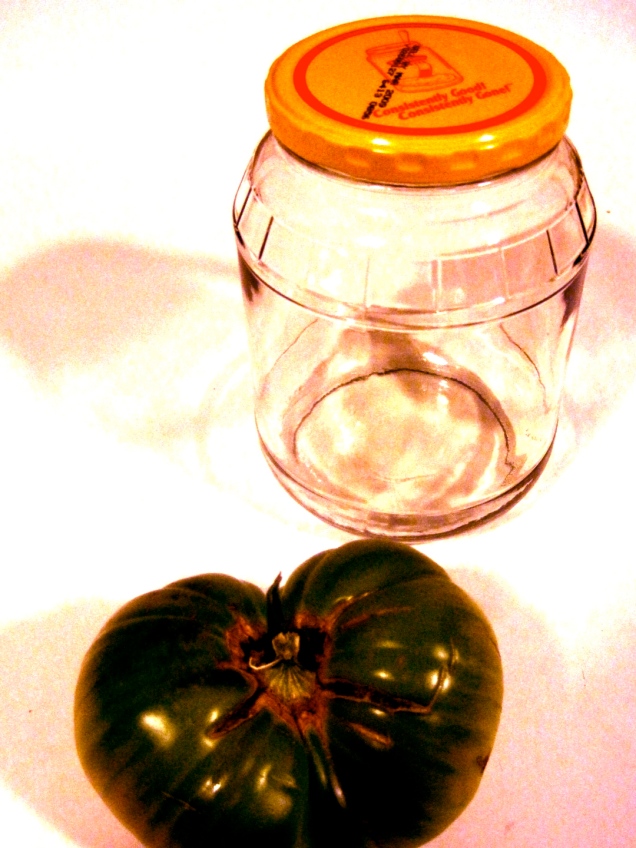
I’ve been busy with the tomato harvest, trying to bottle up the meaty juices of summer before we go back to school next week. I decided to attempt ketchup this year as one of my projects, using what surely absolutely promised to be a quick and easy recipe for blender ketchup, because, you know, it is processed in a blender to speed up the breakdown of the tomato.
It still took all day to cook down into an integrated sauce. Hrmph. But it lacks the HFCS/corn syrup double whammy of Heinz 57, and while sweet, it has a stronger spice profile. I shared my experiences in a ketchup demo segment of the Master Food Preserver condiments class last week. Some people in the condiments class felt it tasted almost like a chili sauce (without heat). Everyone seemed to like the flavor.

I could have (should have) pushed the final product through a food mill, because the texture isn’t as silky as that of Heinz. This picture shows a comparison of my ketchup (top), Heinz, and a green tomato ketchup made by a fellow Master Food Preserver. My ketchup lacks the bitterness of the green tomatoes, but also the onion powder heft of the Heinz, a glaring omission, in my view. I used local sweet onions, but there really is no substitute for onion powder when you’re looking for a deeper onion flavor.
As you can see below, after sitting for a few minutes, the homemade ketchups leaked, mine more than the other.

The onion powder might have helped with thickening, as well. The leaking issue aside, however, the ketchup experiment was fascinating, because it shed some light into older customs of spicing meat.
Ketchup once came in many flavors, including rotten fish, mushroom, and walnut. The oldest customs, traced deep into China and Rome, isolate the process of fermenting and pickling fish as the fundamental ketchup tradition. Later adaptations in England and France (and up into the twentieth century), use vegetables and nuts to make a thin sauce. The recipes I have seen for the 18th and 19th century recipes all contain a familiar spice profile: allspice, mace, clove, cinnamon. These spices still define ketchup, but we add more sugar and vinegar. All of the ketchup recipes I found contained a large amount of one spice with a bitter profile. Some featured dried mustard (the one I used, for example) and others celery seed. I substituted brown mustard seed for the mustard powder in mine to cut the bitterness, again trying to mimic Heinz’s very subtle bitter edge.
Malcolm Gladwell, in a New Yorker article on ketchup’s complex taste, chalks up the thickness of Heinz 57 to pectin, but I’m not sure that’s the whole story. I cooked my ketchup, made with ripe tomatoes and sugar, for at least 5 hours. I even food-milled and squoze the bejesus out of the fleshy skin peelings. Any pectin that was there would have jelled up my sauce. There’s something else in Heinz that makes it that perfect texture, some sort of commercial stabilizer hidden from spies poring over the label, I suspect.

Gladwell calls Heinz 57 “sensorily complete” because it contains the five tastes: salty, sweet, sour, bitter, and umami. Umami is a savory or “meaty” quality, something that mushrooms or soy sauce or cheese contains. And, as Gladwell says, ripe tomato:
When Heinz moved to ripe tomatoes and increased the percentage of tomato solids, he made ketchup, first and foremost, a potent source of umami. Then he dramatically increased the concentration of vinegar, so that his ketchup had twice the acidity of most other ketchups; now ketchup was sour, another of the fundamental tastes. The post-benzoate ketchups also doubled the concentration of sugar—so now ketchup was also sweet—and all along ketchup had been salty and bitter. These are not trivial issues. Give a baby soup, and then soup with MSG (an amino-acid salt that is pure umami), and the baby will go back for the MSG soup every time, the same way a baby will always prefer water with sugar to water alone. Salt and sugar and umami are primal signals about the food we are eating—about how dense it is in calories, for example, or, in the case of umami, about the presence of proteins and amino acids. What Heinz had done was come up with a condiment that pushed all five of these primal buttons.
In the article, food scientists compare Heinz 57 to a homemade ketchup, declaring it lacks the perfect flavor profile of Heinz, and is thus less satisfying. I agree that there’s something very well balanced about Heinz, as terrible and HFCS-y as it is. A very sweet condiment, Heinz really does still have a savory component that was lacking in the two homemade ketchups we tried in the class. I wonder if the earlier versions of ketchup — the fish, mushroom, and walnut versions — were getting at something. Each of them, after all, bears a predominantly umami flavor.

When we test ketchup plain, it really doesn’t work, because we never eat plain ketchup. For the class, I thought they’d kick me out of the MFP program if I brought in McDonald’s french fries, so I fried up hamburgers and let the students do the comparison with bits of ground beef. The conclusion? Everyone liked my ketchup. In a way, however, I feel as if I pulled the wool over their eyes. The one thing my ketchup was lacking was umami. Adding meat, then, made the other flavors seem perfectly balanced. My ketchup suddenly became more spicy than Heinz, with flavors that complimented the meat instead of being too jarringly, well, different than what we’re used to. I was pleasantly surprised, and suddenly, the project seemed to have more value that I had thought. I’m going to do more ketchup tests through the winter, and will report back.
If you’re local and interested in condiment-making, be sure to check out the repeat of our condiment class on October 16. Details to the right. I’d love to see you there!





















You must be logged in to post a comment.